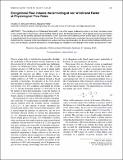Elongational Flow Induces the Unfolding of von Willebrand Factor at Physiological Flow Rates
Author(s)
Sing, Charles E.; Alexander-Katz, Alfredo
DownloadSing-2010-Elongational Flow In.pdf (331.4Kb)
PUBLISHER_POLICY
Publisher Policy
Article is made available in accordance with the publisher's policy and may be subject to US copyright law. Please refer to the publisher's site for terms of use.
Terms of use
Metadata
Show full item recordAbstract
The unfolding of von Willebrand Factor (vWF), one of the largest multimeric proteins in our body, has been shown to be a crucial step in the process of blood clotting. Here we show that elongational flows, which appear during vasoconstriction or stenosis, are the primary activation mechanisms of vWF, and unfold the multimeric protein at flow rates that are two orders-of -magnitude below those corresponding to pure shear. The findings presented here complement the current understanding of blood clotting from the molecular to the physiological level, and provide new physical insights into the connection between clotting anomalies, such as Heyde's syndrome and stenosis. These findings also represent a new paradigm in the function and activation of vWF.
Date issued
2010-05Department
Massachusetts Institute of Technology. Department of Materials Science and EngineeringJournal
Biophysical Journal
Publisher
Elsevier
Citation
Sing, Charles E., and Alfredo Alexander-Katz. “Elongational Flow Induces the Unfolding of von Willebrand Factor at Physiological Flow Rates.” Biophysical Journal 98, no. 9 (May 2010): L35–L37. © 2010 Biophysical Society
Version: Final published version
ISSN
00063495
1542-0086